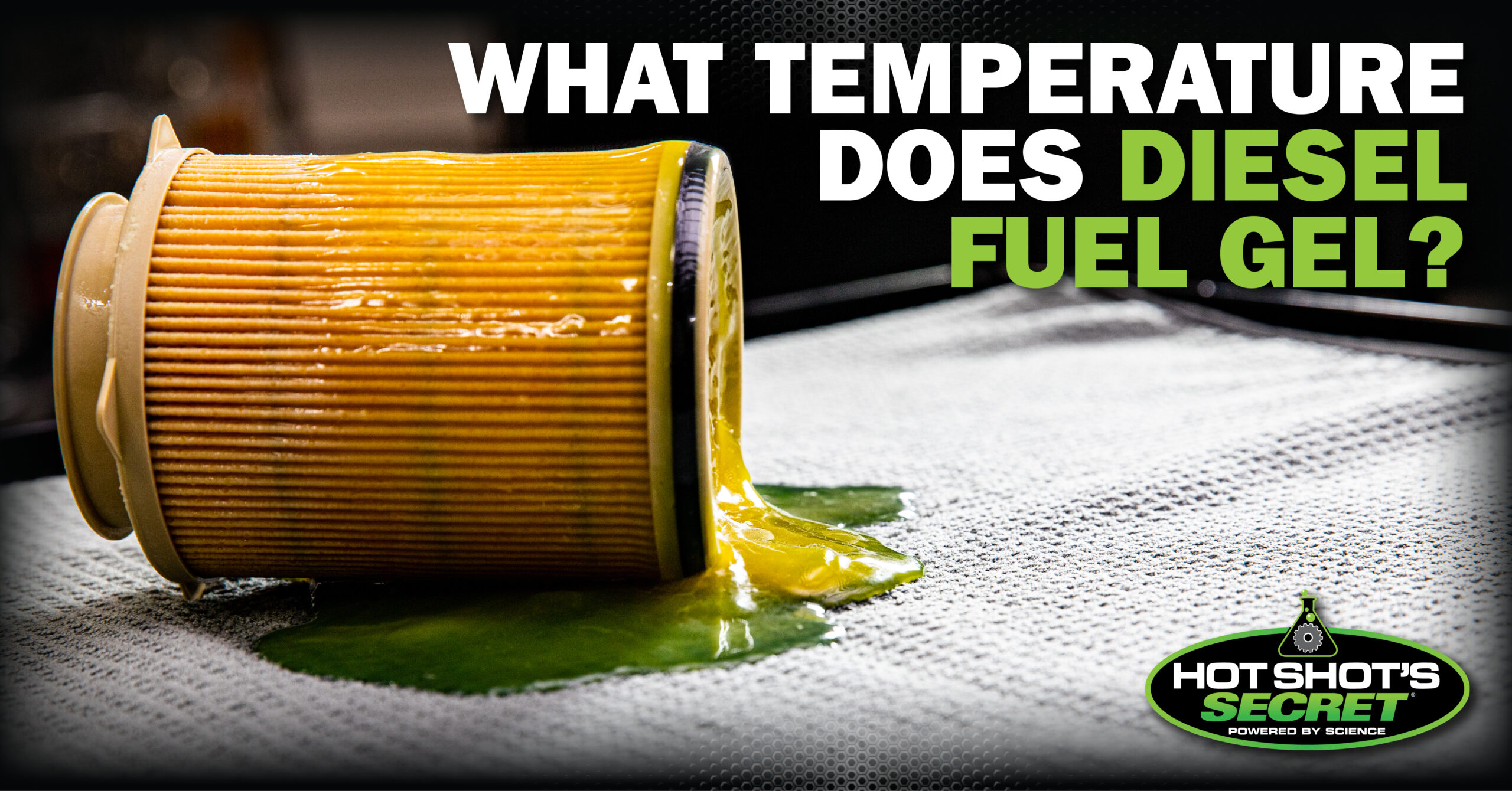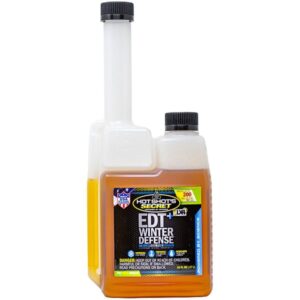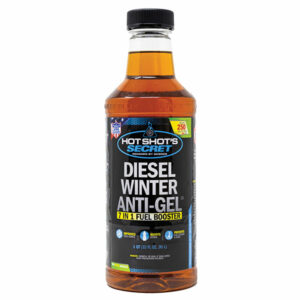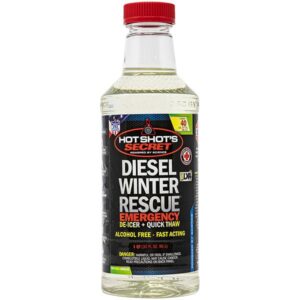
What To Do If Your Diesel Fuel Gels
If you drive a diesel vehicle, you must consider diesel fuel gelling as part of your preventive maintenance routine. Diesel fuel gelling occurs when the fuel thickens or ‘gels’ in cold temperatures, which can hinder the engine’s operations and significantly impact your vehicle’s ability to start. It is common in colder climates and can be managed with various preventive measures, including heat, kerosene and fuel additives like Hot Shot’s Secret’s EDT+ Winter Defense.
Learning about fuel gelling and how to prevent it can help you prepare for winter, drive with ease and have peace of mind that your vehicle is in excellent shape.
We recently caught up with someone who is an expert on winter maintenance to get his advice. David Berg of BayBrook Solutions lives in Mandan, North Dakota, where at the time of this writing, the weather was a balmy 5°F with a 20 mph wind.
“I’m wearing my gloves rated for 40 degrees below zero, and my hands are still very cold,” says David. “We’ve been lucky this year though. So far we have only been down into single-digit temps. By now it’s often 20 degrees below zero here for days and days on end. Brain freeze can happen just by being outside. We used to own a towing company and unfortunately for our customers, we have seen plenty of gelling causing diesel vehicles to not start in the winter.”
Why Does Diesel Fuel Gel?
Diesel fuel gelling occurs when the temperature drops and the paraffin wax in the fuel starts to crystallize and thicken, making the fuel gel-like. This can clog the entire fuel system since the fuel solidifies and loses its ability to flow. Diesel fuel gelling is similar to how a wax candle remains solid until lit, at which point the wax progressively becomes a free-flowing liquid. Then, as it cools, the wax becomes solid again.
At What Temperature Does Diesel Fuel Gel?
Diesel fuel gels when temperatures fall below 10 to 15 degrees Fahrenheit or -12 degrees Celsius. The diesel gelling temperature depends on the composition and quality of the fuel. However, the gelling process starts when the fuel hits the cloud point, which gives it a cloudy appearance. The cloud point can begin at temperatures as high as 32°F but generally starts at 20°F for #2 diesel fuel.
As the temperature continues to drop, the fuel will reach what is known as the pour point, which is usually 6°F to 10°F lower than the cloud point. At this stage, the fuel thickens to the point where it can no longer flow properly. The final stage is the diesel gel point, which occurs when the fuel has completely solidified and no longer flows, usually around 10°F to 15°F.
It’s important to note that if engine complications occur at temperatures above 10°F to 15°F, the issue is likely due to ice rather than gel.
How Can You Tell When Diesel Fuel Begins to Gel?
Berg mentions that there are a few telltale signs that can serve as good indicators that your diesel fuel is starting to gel. This is primarily based on the loss of power and compression caused by fuel failing to reach the combustion chamber. Some of the signs are:
- A cloudy fuel appearance indicates the gelling has already occurred.
- You see white smoke come from the exhaust when trying to accelerate.
- The engine stops running when you’re sitting idle trying to throttle.
- The vehicle starts but doesn’t run continually.
Whether it’s the lack of RPMs when an engine is running or one of those cold winter mornings when the truck just won’t start at all, gelled diesel fuel is probably the culprit.
How Can You Prevent Diesel Fuel From Gelling?
Managing diesel fuel gelling is critical to ensure the reliable and efficient operation of diesel engines. Preventing fuel from gelling involves keeping it warm or changing its properties so it can withstand colder temperatures. Here are the solutions you can use.
Heat
Heat can help prevent fuel gelling by reducing your engine’s exposure and vulnerability to cold temperatures. You can protect your vehicle with the following solutions:
- Warm storage: Store your vehicle in a climate-controlled garage or heated environment to protect it from freezing outdoor temperatures.
- Light bulbs: Placing light bulbs under your vehicle allows them to emit heat and keep your engine warm.
- Tarp and heater: Wrap your vehicle in a tarp and run a heater that blows heat to warm your vehicle overnight.
- Block heater: A block heater connects to your engine and warms your engine’s coolant, keeping your oil warm to prevent freezing.
When you use heat to prevent freezing and gelling, you must also consider energy consumption and how to protect your vehicle away from home. Storing your vehicle in a climate-controlled garage is an effective way to protect it while you’re at home, but it can quickly increase your energy bill. Light bulbs, heaters and block heaters require electricity to work, so you may need to consider other methods if you want to protect your vehicle while keeping energy bills low.
You also need to protect your vehicle while it sits at your workplace throughout the day or when you leave it in a parking lot during travels or vacations.
Kerosene
Using kerosene to prevent diesel fuel from gelling is a common solution that involves modifying the fuel mixture itself. Kerosene has a lower gelling point than diesel fuel. As such, you can mix it with diesel fuel to lower the point of freezing. You can also get kerosene-blended fuel, which often combines #1 diesel and #2 diesel. However, kerosene has its disadvantages, such as reduced fuel mileage and efficiency.
If your truck stops running and you choose to use kerosene, it is highly advisable to let the engine run long enough to combine the fuels properly and provide a steady flow of the mixture. For example, a semi-truck contains hundreds of fuel gallons and requires a considerable amount of time for kerosene to thaw the tank. The kerosene must also thaw the clogged fuel filter and frozen lines. It may take an hour of idling to thaw the entire line from the fuel tank to the filter and the injectors.
Fuel Additives
Newer fuel additives serve as easy, low-cost and hassle-free solutions to prevent fuel gelling. With the right fuel additive, you can avoid and solve engine complications without making expensive repairs. Using only the highest-quality fuel additives is essential to protect your vehicle effectively.
Additives provide temperature coverage to help prevent your diesel fuel’s wax from thickening, but you should choose an additive that also improves your fuel’s water dispersion, lubricity and cetane to ensure its success.
Hot Shot’s Secret has various top-quality fuel additives available, such as EDT+ Winter Defense and Diesel Winter Anti-Gel, which reduce fuel line freeze-ups down to -40 °F. Diesel Winter Anti-Gel lowers your fuel’s cold filter plugging point (CFPP) to prevent your fuel lines and filters from clogging. EDT+ Winter Defense is an everyday treatment with anti-gel properties that prevents the formation of clumps and allows fuel to flow freely at low temperatures.
Do You Need to Add Anti-Gel to Diesel Fuel?
Anti-gel lowers the temperature at which diesel starts to gel, helping to prevent fuel system blockages and ensure smooth engine operation. Adding anti-gel to diesel fuel is a cost-effective solution to prevent your vehicle from breaking down, saving you time and money.
Berg says, “If a tow truck is called, you may still be stuck with a vehicle that won’t run after paying the tow fee. In the case of a personal or small-duty vehicle, you can save yourself the lost $80 and the hassle, or in the case of a semi, the $500 price tag for a tow and lost time headed down the interstate. Instead, for only a few dollars in prevention and an easy pour into the tank, taking advantage of the top scientific additives could keep you from being stranded in the cold.
How Do You Ungel Diesel?
Ungelling diesel involves warming up the fuel system, which can be done by moving the vehicle to a warmer place or using engine block heaters. You can also add a diesel fuel anti-gel additive to the tank, which helps dissolve the gel and return the fuel to a liquid state.
Will Gelled Diesel Thaw?
It is possible for diesel fuel to thaw if the engine’s temperature gets back to normal. However, if your engine breaks down on the road or you don’t have a heated place to store your vehicle, thawing your engine may not be an option. Emergency fuel additives can help thaw gelled fuel inside the fuel tank.
Emergency additives are available if you skip prevention and the fuel gels or gelling remains a possibility. Hot Shot’s Secret offers Diesel Winter Rescue to help you solve gelling and icing issues.
Diesel Winter Rescue is a formulated product that thaws frozen filters and reliquifies gelled diesel to restore the engine’s fuel flow. This high-quality product restores an engine’s full operational capabilities. Products such as Diesel Winter Rescue are a helpful option to carry in your vehicle during the winter months in case complications arise.
Prepare Your Diesel for Winter With Hot Shot’s Secret’s Diesel Winter Anti-Gel
Understanding how to prepare your diesel for winter can help you keep your vehicle running on the coldest days. The most effective way to protect your vehicle from freezing temperatures is to lower your fuel’s CFPP with a high-quality additive. Hot Shot’s Secret offers EDT+ Winter Defense and Diesel Winter Anti-Gel to reduce your fuel’s CFPP and prevent your fuel filters and lines from clogging.
EDT+ Winter Defense and Diesel Winter Anti-Gel also boost your fuel’s cetane number and improve your fuel’s stability, winter operability, detergency and lubricity. Purchase Diesel Winter Anti-Gel online or locate a store near you to start preparing for winter.



